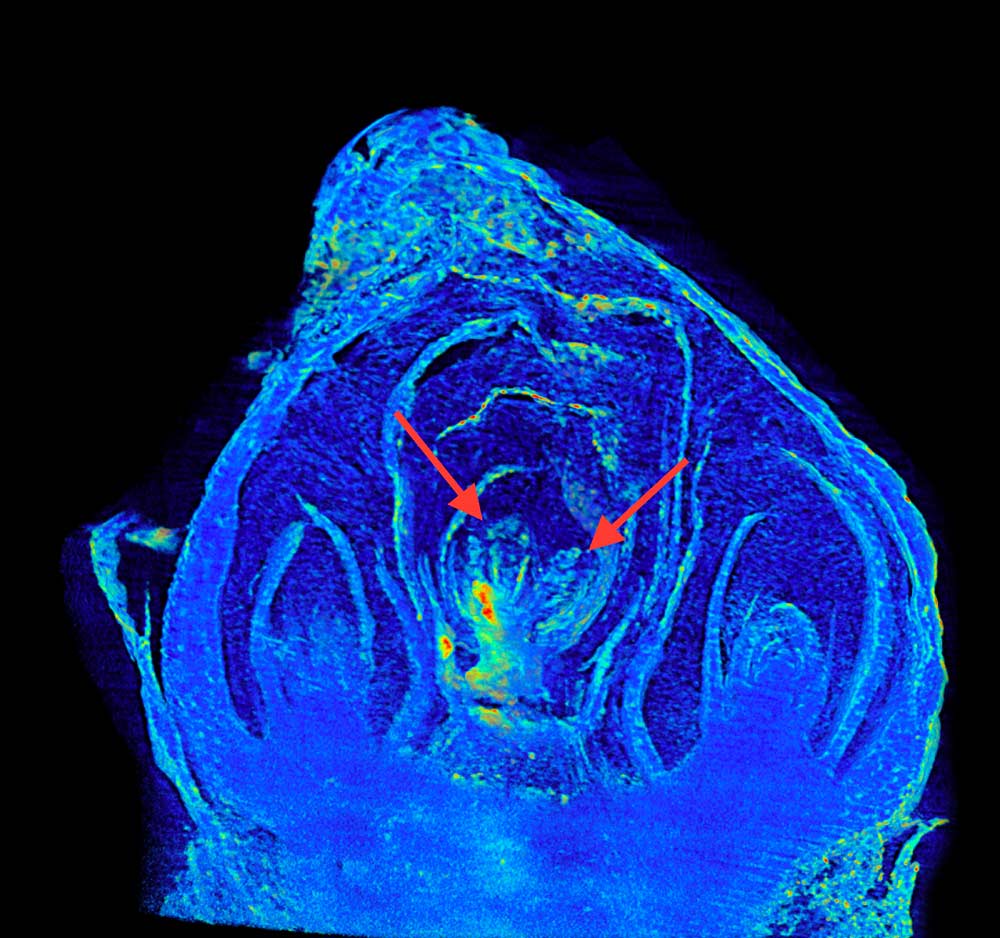Using an advanced type of X-ray imaging to examine ice formation inside wild grape buds, a researcher is getting a highly detailed, three-dimensional view that may help pinpoint the genes responsible for their exceptional cold hardiness.
Such insight could subsequently be used to improve winter survival of vinifera grapes.

CHESS yields parallel X-rays that provide highly detailed, three-dimensional images of grape buds, including this internal view of early flower formation (indicated by arrows) within a vinifera bud. (Courtesy of Al Kovaleski)
Improving the freeze tolerance of vinifera grapes is especially important with the increasingly variable winters occurring in the Northeastern and Midwestern United States, said Al Kovaleski, a doctoral student in the horticulture section of the School of Integrative Plant Science at Cornell University.
“Grapevines that have already fulfilled all of their chill requirements can actually come out of the cold-resistant state very quickly, so if a warm spell happens later in the winter and temperatures then drop again, those grapes are prone to suffer cold damage,” he said.
To study why wild grapes are hardier than vinifera grapes, Kovaleski is using something nearly unprecedented in horticultural circles: a particle accelerator known as a synchrotron.
Specifically, he is employing the Cornell High Energy Synchrotron Source (CHESS).
One of the few such facilities in the world, CHESS is an underground half-mile loop in which electrons speed around to generate extremely high-energy, parallel X-rays. He is using those X-rays to image the buds.
These synchrotron’s parallel X-rays are extremely sensitive and can pick up detail that is invisible to a normal medical X-ray.
“The X-ray that is used for a broken bone, for example, is an absorption X-ray, which means that a portion of the X-rays is absorbed by the higher density of the bone, and that contrast creates an image,” he explains.

Researcher Al Kovaleski of Cornell University is using advanced X-ray technology and a particle accelerator called the Cornell High Energy Synchrotron Source (CHESS) to isolate the genes that give wild grapes their extreme cold hardiness, with hopes of conferring similar winter-survival characteristics to vinifera grapes. (Courtesy of Cornell University)
Plant tissue doesn’t have those sorts of high-density differences, so absorption X-rays don’t work.
When the synchrotron’s parallel X-rays are focused on a bud, however, they are scattered ever so slightly by even miniscule variations, such as the difference between liquid water and ice crystals.
“That’s how we can identify where the ice is located during the freezing of the bud,” he said.
Details about chilling are significant because in wild grapes, certain parts of the bud develop ice crystals when the temperature drops below freezing, but others do not.
Instead, the water in the unfrozen areas remains in a liquid state — a process called supercooling — and that protects bud tissue.
By tracking when and where the ice forms, Kovaleski is figuring out what mechanisms are involved in supercooling, as well as the genes that trigger those mechanisms.
Although the genetics part of the analysis is just beginning, he is hopeful that the vast quantity of synchrotron data he has already collected will provide important clues to benefit vinifera grapes.
“Currently the only way the people can cope with winter bud damage in the Midwest and Northeast is by leaving more material when they’re pruning, but if we can identify the influence of a specific gene and can then trigger that gene by some sort of chemical application, for instance, we could improve the plant’s overall cold hardiness,” he said. “In addition, perhaps we can find a specific set of genes that would be beneficial when developing new cultivars.
“That’s the idea. That’s the hope.” •
– by Leslie Mertz






Leave A Comment